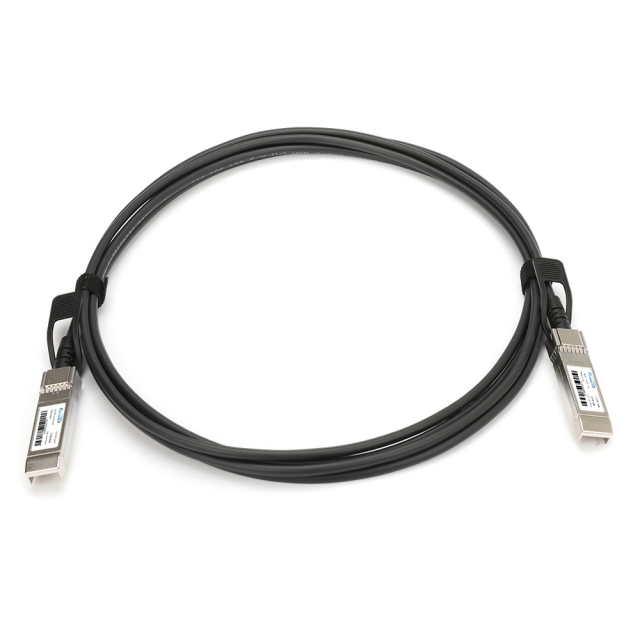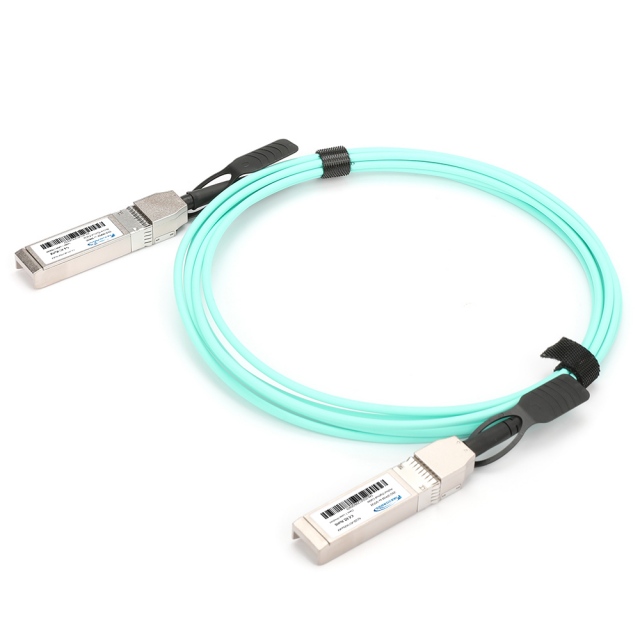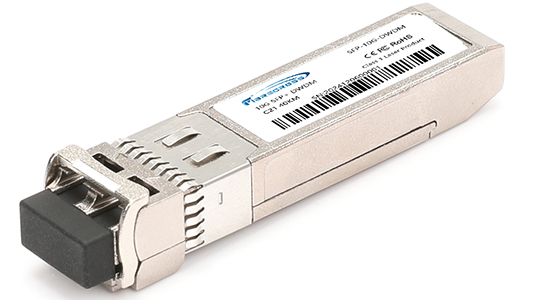Ultimate Guide to 10G SFP+ AOC Cables: Reliable, Scalable, and Cost‑Effective
As data center and enterprise network demands continue to grow, 10G SFP+ AOC cables—also known as 10G SFP+ active optical cables or simply 10G AOC cables—have become the go‑to solution for high‑speed, low‑latency interconnects. Whether you’re upgrading server‑to‑switch links, extending top‑of‑rack connections, or integrating into high‑performance computing clusters, these cables offer advantages that copper alternatives cannot match. In this comprehensive guide, we’ll explore everything you need to know—from technical features and real‑world applications to installation best practices, case studies, troubleshooting, market trends, and wholesale purchasing tips.
What Is a 10G SFP+ AOC Cable?
A 10G SFP+ AOC cable is a factory‑terminated active optical assembly that combines optical transceivers and fiber within a standard SFP+ housing. Key characteristics include:
Integrated Optics and Electronics: Embedded transceivers at both ends handle conversion between electrical 10 GbE signals and optical wavelengths.
Optical Fiber Core: Typically multimode fiber (OM3 or OM4) for links up to 100 m.
SFP+ Form Factor: Fits directly into standard SFP+ ports on switches, routers, network interface cards (NICs), and other equipment.
Unlike passive copper DACs (Direct Attach Cables), AOC cables contain active components that boost signals, enabling significantly longer distances and superior signal integrity.
Key Features and Specifications
When evaluating 10G AOC cables, pay attention to these critical specifications:
| Specification | Typical Range |
|---|---|
| Data Rate | 10.3125 Gbps (IEEE 802.3ae) |
| Maximum Reach | 30 m (OM3), 100 m (OM4) |
| Connector Type | SFP+ housing with LC duplex plug |
| Fiber Type | OM3 / OM4 multimode fiber |
| Cable Jacket | LSZH or PVC |
| Bend Radius | ≥ 30 mm |
| Power Consumption | < 1 W per transceiver |
| Operating Temperature | 0 °C to 70 °C |
| Storage Temperature | –40 °C to 85 °C |
| Compliance | SFP+ MSA, RoHS, CE, FCC |
These parameters ensure compatibility, reliability, and performance across a variety of environments.
Benefits of 10G SFP+ Active Optical Cables
Extended Reach: Achieve distances up to 100 m without repeaters or signal boosters.
Improved Airflow & Weight Reduction: Thin, lightweight cables reduce rack clutter and improve cooling efficiency.
Electromagnetic Immunity: Optical fiber is immune to EMI and RFI, ensuring stable performance in electrically noisy environments.
Lower Power Draw: Active optics typically consume less power per link compared to copper solutions with equal reach.
Future‑Proofing: Supports migration to 25 G, 40 G, and beyond by leveraging higher‑grade fibers and similar modular form factors.
Real‑World Applications
Server‑to‑Switch Connectivity
In leaf‑spine topologies, 10 GbE links over AOC cables reduce link saturation and maintain low latency.Top‑of‑Rack (ToR) Deployments
Rack density increases, yet AOC cables consume minimal space, enabling more ports per switch without compromising airflow.High‑Performance Computing (HPC)
Clusters handling scientific simulations, big data analytics, and AI/ML workloads rely on tight latency budgets; AOCs deliver deterministic performance.Storage Area Networks (SANs)
iSCSI and Fibre Channel over Ethernet (FCoE) environments leverage AOCs for uninterrupted 10 GbE connectivity.Campus and Metro Links
In tightly‑packed telecom closets or small data aggregation points, 30–100 m reach covers most campus requirements without intermediary hardware.
Installation Best Practices
Verify Compatibility: Ensure all network devices support SFP+ and the specific wavelength used by your AOC cable. Consult vendor compatibility matrices.
Handle with Care: Avoid sharp bends—maintain at least the minimum bend radius (≥ 30 mm). Pull cables by the connector housing, not the fiber jacket.
Label and Document: Color‑code or label each cable at both ends to simplify future maintenance and avoid mispatching.
Test After Deployment: Use an SFP+‑compatible diagnostic tool to verify link integrity, signal strength, and error rates.
Maintain Cleanliness: Keep LC ferrules dust‑free by capping unused connectors and using fiber‑safe cleaning kits before insertion.
Proper installation not only maximizes performance but also extends the operational lifespan of your AOC cables.
Maintenance and Monitoring
SFP+ Diagnostic Monitoring (DDM/DOM): Leverage DDM features to monitor real‑time parameters such as temperature, voltage, transmit/receive power, and optical performance.
Scheduled Inspections: Every 6–12 months, visually inspect cable paths for signs of wear, kinks, or mechanical stress—especially in high‑traffic areas.
Firmware Updates: Keep network device firmware current to benefit from improved SFP+ module interoperability and updated diagnostic thresholds.
Environmental Controls: Maintain ambient temperatures within the recommended operating range (0 °C to 70 °C) and monitor humidity to prevent condensation.
Troubleshooting Common Issues
| Symptom | Possible Cause | Recommended Action |
|---|---|---|
| Link Drops or Flapping | Dirty connector or fiber bend | Clean ferrules; verify bend radius compliance |
| High Bit Error Rate (BER) | Fiber degradation or transceiver fault | Run loopback tests; replace suspect AOC module |
| No Link Detected | Mismatch of SFP+ DDM codes or optics | Confirm wavelength compatibility; check port settings |
| Elevated Transmit Power Alarm | Dirty fiber end-face or connector issue | Clean connectors; reseat module |
| Excessive Temperature Warnings | Overheating due to poor airflow | Re-route cable for better airflow; inspect rack fans |
By systematically isolating variables—cable, port, device—you can identify and resolve faults quickly.
Case Study: Hyperscale Data Center Upgrade
Background: A large web‑scale provider needed to upgrade server‑to‑spine links from 1 GbE to 10 GbE across a 3,000‑rack facility.
Challenge: Maintain minimal downtime, avoid expensive re‑cabling projects, and improve energy efficiency.
Solution: Deployed 10G SFP+ AOC cables (OM4) in a leaf‑spine fabric.
Implementation Time: 48 hours of staged rollouts during maintenance windows.
Results:
Link reliability improved by 99.99%.
Average rack power draw reduced by 15 W per link.
Cooling load decreased by 5% due to lighter cabling and improved airflow.
This case underscores how AOCs can accelerate upgrades and deliver both performance and OPEX benefits.
Market Trends and Future Outlook
Growing AOC Adoption: By 2027, the active optical cable market is projected to grow at a CAGR of over 12% as data center operators chase higher bandwidth and lower latency.
Pulse Towards Higher Speeds: While 10 GbE remains ubiquitous, migration to 25 GbE and 50 GbE optical interconnects is well underway; form‑factor innovations (e.g., SFP28 and QSFP) leverage lessons learned from 10G AOCs.
Eco‑Friendly Designs: Newer AOCs are built with recyclable materials, lower-power electronics, and support for dynamic power scaling based on link utilization.
Software‑Defined Monitoring: Integration with telemetry frameworks (gNMI, OpenConfig) allows real‑time visibility into optical performance at scale.
Staying abreast of these trends helps network planners future‑proof investments and align with evolving industry standards.
Wholesale Purchasing Tips
If you need to wholesale 10g sfp aoc cables, keep these considerations in mind:
Certifications & Compliance: Verify SFP+ MSA, RoHS, CE, and FCC markings to ensure interoperability and environmental safety.
Vendor Reputation: Look for suppliers with proven quality control, traceable manufacturing (e.g., ISO 9001), and transparent test reports.
OEM vs. Third‑Party: Third‑party options can reduce costs by up to 30% without sacrificing performance—but confirm warranty terms and end‑to‑end support.
Stock & Lead Times: High-volume vendors often keep OM3/OM4 AOCs in stock; confirm minimum order quantities (MOQs) and shipping timelines to align with project schedules.
Custom Length Options: To reduce excess slack and airflow disruption, many suppliers offer custom lengths in 1 m increments up to 100 m.
After‑Sales Support: Opt for vendors providing 24/7 technical assistance, advance replacement programs, and interoperability matrices.
Conclusion and Next Steps
Upgrading to 10G SFP+ active optical cables is a strategic choice for organizations seeking high bandwidth, energy savings, and future scalability. From the data center’s leaf‑spine fabric to campus aggregation points, these AOCs deliver robust, low‑latency performance with reduced cabling overhead.
Next Steps:
Assess Your Network Needs: Conduct a port‑density and distance audit to determine fiber grade (OM3 vs. OM4) and cable lengths.
Pilot Deployment: Test AOC links in a controlled rack segment, monitoring DDM metrics and link stability.
Scale Rollout: Stage mass deployment during maintenance windows to minimize operational impact.
Implement Monitoring: Integrate optical telemetry into your network management system for ongoing health checks.
Engage Experts: Consult with optical interconnect specialists to optimize your architecture and plan future upgrades to 25 GbE and beyond.
Feel free to reach out to Fibrecross ‘s sales and engineering teams for detailed specifications, custom quotes, or on‑site consultation. Empower your network with the high‑performance, energy‑efficient connectivity that 10G SFP+ AOC cables provide—today and tomorrow.






